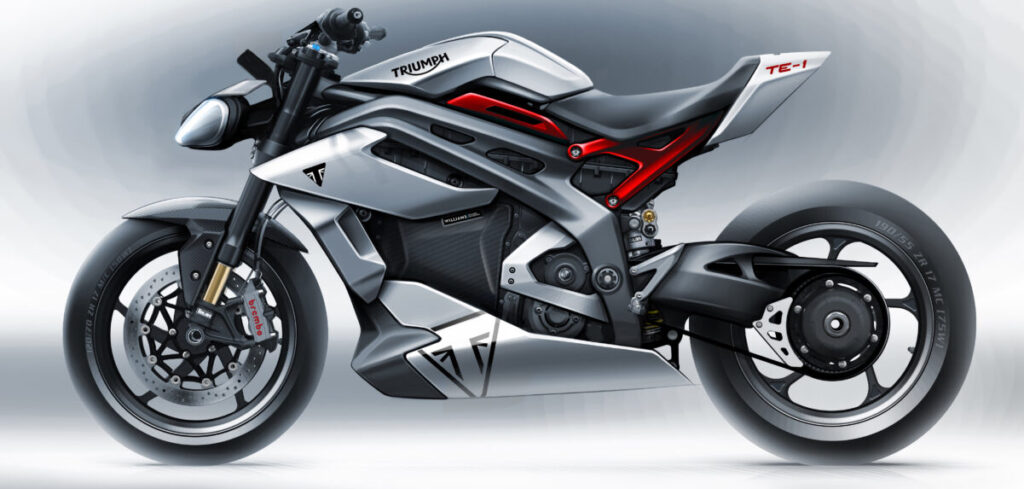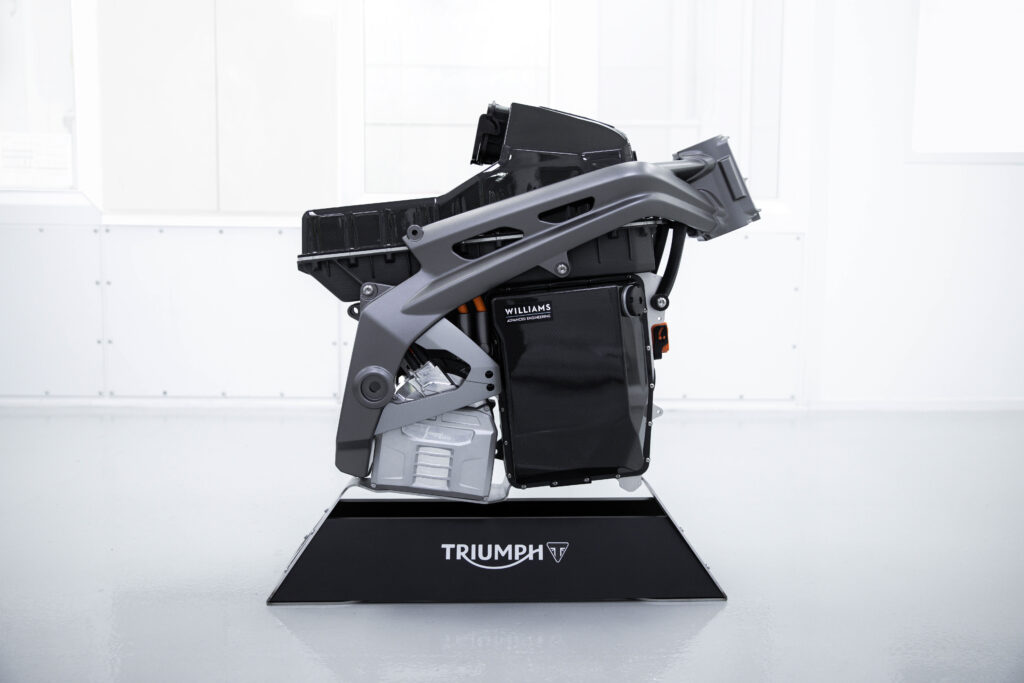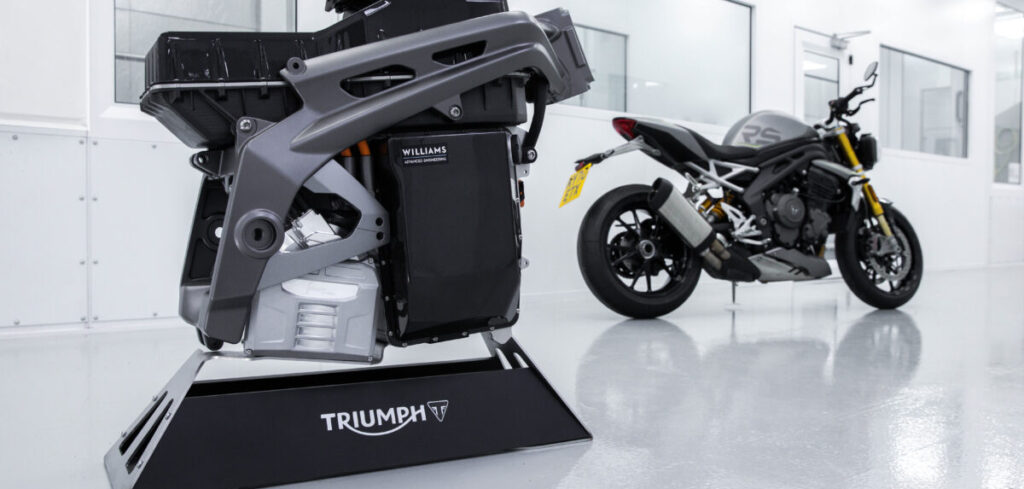The developers of a remarkable new electric motorcycle discuss the intricacies of the testing program for this landmark project
In May 2019, a collaborative new project was initiated between Triumph Motorcycles, Williams Advanced Engineering, Integral Powertrain and WMG at the University of Warwick, to design and build high-performance electric motorcycle technology. Following completion of phase two of the development program, with a further two phases to follow, the first prototype images of the electric motorcycle have been released. Housing a newly developed battery and powertrain architecture, the motorcycle is said to have produced performance results beyond initial targets, beating current benchmarks.
Project TE-1 powertrain specifications
UK-based outfit Williams Advanced Engineering (WAE) has been responsible for developing the battery tech. Based on the agreed specification, WAE identified appropriate cell technology and battery architecture to deliver the performance objectives. Using this as a framework, the team then optimized the battery module layout to balance mass and positioning within the prototype chassis, taking into consideration center of gravity, space and relationship with the powertrain and charging approach.
In addition to the module layout, the team has developed a unique new vehicle control unit that is integrated into the battery pack to minimize weight and packaging. In parallel, WAE has also created specialist battery management software to ensure power is delivered in accordance with battery performance.
Phase 2 of the project, which involved bench testing, is said to have shown performance results that exceed anything else on the market in terms of power and energy density.
“Within the current landscape, most electric motorcycle technology arguably delivers compromised performance at low levels of battery charge. By using a lightweight, compact solution we have been able to give the rider all of the performance all of the time (regardless of battery charge), and a class-leading range. We have focused on pushing the boundaries to reduce mass and optimize frame position to benefit handling. We have also pushed the limits of battery performance, balancing the design for acceleration and range, with simulations modeled on track-based riding. In other words, as aggressive as possible,” said Dyrr Ardash, senior commercial manager, Williams Advanced Engineering. “The energy density of this new battery will be a significant step forward from existing technology, giving the rider more power for longer. WAE has also designed and developed an electronic control unit from the ground up, combining the battery management system with the bike control functions in one package.”
Integral Powertrain (IPT) has developed a unique motor and inverter design. In phase 1, the company worked to integrate the normally separate motor and inverter into one single, compact package. Integration reduces the mass and volume of the drivetrain by reducing additional boxes on the vehicle, mounting features, coolant pipework and heavy high-voltage connections.
The integration concept is also a fully scalable one, whereby the number of power stages can increase for larger-diameter, higher-torque motors, for example. Combined with Integral’s state-of-the-art motor technology, the motor has achieved a power density that is twice that of the target set by the UK Automotive Council for 2025.
Advanced silicon carbide switch technology is applied in the inverter; this reduces losses and results in greater drivetrain efficiency, power delivery and range.

“One of the most influential factors in how well a motorcycle handles and performs is mass, so at Integral Powertrain we have focused heavily on making a step change in motor and inverter design, removing heavy high-voltage cables, for example. This delivers a product that is significantly more compact and lighter than anything currently available on the market. The motor produces 130kW or almost 180hp, but weighs only 10kg, much lighter than existing technology and clearly a small fraction of the mass of traditional internal combustion engines,” said Andrew Cross, chief technical officer at Integral Powertrain.
WMG worked closely with all the TE-1 partners to develop representative models to simulate the systems of the bike, including battery, motor and vehicle control. This enabled validation of the specification against the intended component selection by assessing performance criteria such as range and top speed with initial models.
This has enabled Triumph to carry out software development at an early stage prior to hardware being built. Recently it has conducted powertrain rig testing using the prototype IPT powertrain to ensure simulations were accurate and to confirm that the motor functions within the system as intended.
“Our creation of initial computer-based simulation models at the start of phase 1 has been instrumental in ensuring that the component selection was appropriate to achieve the performance targets defined by the partners for the TE-1 prototype,” said Truong Quang Dinh, assistant professor of energy management and control systems at WMG, University of Warwick.
“We have continued with this work across phase 2 of the project, refining the models to a much more complex level to allow us and the partners to imitate further components on the bike such as braking, throttle, lighting and other systems, and mimic real-world riding to provide development opportunities before components were fully designed. Additionally, we have created a physical rig wired with all of the control units, in order to implement a design validation test program to ensure the function of each section was within the allowable range.”
Responsible for the development of the chassis, motorcycle manufacturer Triumph has also engineered advanced vehicle control software that incorporates all of the electrical systems to ensure intuitive throttle response, regen braking, traction control and all of the dimensions that a user would expect.
Steve Sargent, Triumph’s chief product officer, said, “The starting point for us in the TE-1 project was to gather important customer feedback about what riders really want from their motorcycles and understand how an electric motorcycle can provide the experience that riders desire. This includes considering the type of riding, range, feel and nature of power and torque delivery together with the ergonomics and bike controls. Taking all of this feedback into consideration, we began the chassis design, focusing on bringing everything together on the TE-1 prototype in a way that provides a riding experience that is exciting and new but ultimately familiar. We have begun to define the powertrain and battery interaction through the use of software refinement to deliver an exhilarating power delivery and throttle response, which provides great control and feels intuitive to the rider.”



